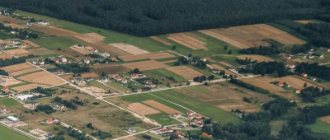Land in lowlands, with difficult terrain, infertile or heavy soil is often allocated for dachas. Their owners make a lot of efforts to bring their land holdings into a condition suitable for the construction of a permanent structure, for gardening or vegetable gardening.
One of the most common methods of such preliminary improvement is filling the area with soil, sand or crushed stone.
There are many “indications” for performing this activity:
- the dacha is located below the level of the adjacent territories;
- the presence of swampy areas and salt marshes - they will prevent the cultivation of various garden and vegetable crops;
- a high level of groundwater is a threat of flooding of the foundation and waterlogging of the soil;
- significant slope - you will encounter soil washout;
- large differences in relief - you will have problems with soil cultivation and construction work;
- Too thin a layer of fertile soil means the land is unsuitable for gardening.
Owners of wetlands will certainly face the following problems:
- the difficulty or impossibility of growing many types of plants, especially woody ones, due to the increased acidity of the soil;
- a more expensive foundation will be required - pile or strip;
- dampness in buildings;
- mosquitoes
Filling the area with sand and gravel
You can simply buy soil for filling the site from us and carry out the work of raising the site on your own. But, as practice shows, independent attempts to level the terrain with a rise in height often led to dire consequences - with an impressive expenditure of effort and money, it was not possible to eliminate the problem, and in some cases it even turned out to aggravate it.
Due to illiterate work, natural drainage was disrupted, followed by flooding of the foundation and a decrease in soil fertility. If you find at least one or two of the problems listed above, specialists are ready to begin solving it
Basic conditions
The procedure for increasing the territory is carried out in accordance with Federal Law No. 93, some provisions of which are called the law on dacha amnesty. This is a simplified scheme, which is allowed for plots acquired after 2001 since the introduction of the Land Code of the Russian Federation. The additional plot registered as a property under this scheme is called an extension.
The increase in area is regulated by Chapter 4 of the Land Code. The legislation establishes the concept of redistribution of territory. As a result, citizens have the opportunity to legalize the addition of a land plot occupied without permission or one that the citizen is only planning to annex.
Citizens who are owners of plots for individual construction, gardening, vegetable gardening and even agricultural purposes can apply for the procedure.
To carry out the procedure correctly, the following conditions must be met:
- The land must have the same territory as the main plot;
- It should not fall under public lands;
- The total size of the plot should not exceed the established standards.
Thus, in the Moscow region, the maximum size of a plot for individual housing construction is from 6 to 15 acres. The territory of the site cannot be expanded at the expense of roads, communications and other significant objects. In addition, it is impossible to add forest and coastal areas to the site.
An increase in area or so-called addition is possible at the expense of state or municipal territories not used for other purposes. Private land belonging to neighbors cannot be subject to this procedure. As a rule, these are small plots that are located in a dead end or surrounded by other plots with no access possible.
The size of the attached area is calculated individually, but it should not be more than 10% of the size of the main area. If the maximum area is exceeded, you will have to create a new plot through Rosreestr and buy it at the established cadastral value. To find out the exact limits, you must contact your local administration. This is due to the fact that each region sets its own standards.
Calculation of the amount of sand for sand preparation
As a rule, during any construction work, it is important to at least approximately know the amount of materials in order to understand the approximate amount of upcoming expenses.
In our specific case, we need to find out how much sand needs to be brought in for leveling work.
To do this, you need to know the area of the site and the thickness of the sand soil for backfilling. We find out the area when we multiply the sides of the plot - we multiply the width by the length, we get the number of square meters of the plot.
For example, it is necessary to level 6 acres of land (600 m2), the backfill height is 0.5 m. We calculate the volume of sand:
- 600 * 0.5 = 300 m3.
After compaction, the sand settles down, the thickness decreases, therefore, according to unwritten construction laws, we add another 10% to the resulting figure, we get 330 m3 of sand.
When ordering sand for delivery, you need to take into account the capabilities of dump trucks, for example, a Kamaz can load 12 m3, a Maz will take 6 m3, and a Zil will take 3 m3 of sand. It is better to buy in dry weather, when the material is dry, otherwise excess moisture increases the weight of the sand.
Sand for filling the site is used in the usual quarry form; this is the most inexpensive option, which is used for rough work.
How to officially legitimize the expansion?
First of all, it is necessary to obtain ownership of the main plot, if this has not been done previously. It is possible to legalize an increase in the area of a land plot after setting boundaries and registering the main plot with cadastral registration. According to a simplified procedure, the following documents are submitted to Rosreestr:
- Passport;
- Statement of the established form;
- Cadastral passport for the plot;
- Document of title on the basis of which property is acquired (sale and purchase agreement, privatization deed, deed of gift, certificate of inheritance);
- Receipt for payment of state duty.
After registration, an extract from the Unified State Register is issued, which shows the ownership of a certain plot.
Geodetic works
After receiving the property documents for the main plot, you need to carry out land surveying. For this purpose, a licensed cadastral engineer or employees of a geodetic company are invited. As a result, the owner receives a land surveying project and a layout plan for the expanded site.
The specialist must make sure that there are no claims to the territory by third parties and that it is not owned by another landowner. Measurements are taken and boundaries are set so that there is no overlap with neighbors' territory.
It is important to make sure that there is no conflict or disagreement on their part regarding the passage of borders. As a result, a boundary plan and an act of completion of work are prepared, in which the owners of adjacent plots, if any, must sign. If everything is in order, you can proceed with further paperwork.
Application to the administration
The owner must contact the administration responsible for the distribution of land in his area. You must submit an application and attach title documents for your site and a boundary plan. If the application is filled out incorrectly, does not correspond to information from the documents, or is submitted to the wrong authority, it will be returned within 10 days with an indication of the reason. If everything is correct, the issue of land allocation is considered within 30 days.
During this time, the municipality makes a decision on approving the site layout. The owner receives consent to conclude an agreement on the redistribution of plots in accordance with the approved boundary plan. Before the expiration of the 30-day period, a redistribution agreement is signed.
Changing the boundaries of the site
Next, the boundaries are clarified, for which it is necessary to complete the registration steps. Otherwise, at the official level, it will be impossible to be considered the owner and fully manage the new territory. To do this, the following documents are submitted to Rosreestr:
- Statement;
- Extract from the Unified State Register of Real Estate;
- Title document for land;
- Passport;
- Land surveying project;
- Layout of the expanded section;
- Positive decision of the administration to allocate a new territory.
Upon completion of the work, the applicant receives an extract from the Unified State Register of Real Estate with the new configuration of the site and area. In fact, you have to carry out the entire range of work at your own expense, including cadastral work. This is convenient for state and municipal authorities, since they do not have to spend budget funds, and taxes are received into the budget.
Payment amount
According to Art. 39.28 of the Land Code of the Russian Federation, the amount of payment for the added plot is established by state, regional or municipal authorities. It depends on the territory. To calculate the full payment, the indicators of cadastral value, total area and connection payment as a percentage of the cost are used.
You can find out the cadastral value yourself if the plot is in the real estate register. To do this, you will need a conditional or cadastral number and the exact address of the location. If you don’t have time to search for a site yourself in the database, you can send an electronic request to Rosreestr. In most cases, a small part of the unused plot is added, so about 15% of its cadastral value is paid.
Please note that payment for the increase in the plot is not allowed in installments or with a deferment. It is important to apply if you already have funds to purchase the plot.
Costs are significantly lower than market value for the following reasons:
- The site is usually expanded due to ownerless land;
- The occupied territory is fenced off long before official registration, which is actually considered squatting;
- Cadastral valuation is carried out according to a special algorithm, as a result of which the value is lower than the market value.
Despite the low cost, in many cases you have to pay for cadastral work. The cadastral engineer prepares a conclusion that may cost more than the attached plot.
FILLING UP A SWAMPY AREA
Filling a swampy area with a high groundwater level or with a large slope is a rather labor-intensive process. Its high-quality implementation can only be done by professionals for several reasons:
- engineers will be able to conduct geodetic research and determine the scope of work;
- they will select the technology taking into account the level of elevation of the territory and the wishes of the customer;
- will select bulk material of the required fraction to prevent soil washout and subsequent subsidence.
When they can refuse
Almost no one is refused at the time of receiving documents, so it is important to monitor the process of the registrar’s work and be ready to provide additional documents. Refusal is possible in the following cases:
- The information from the application and documents does not correspond;
- There is no written consent of third parties if the redistribution of land affects their interests;
- The annexed plot is withdrawn from land circulation or limited;
- Bidding has been announced for the plot;
- The site contains real estate objects owned by citizens, state or municipal bodies;
- The area of the plot is 10% larger than the main one;
- The annexed land is subject to independent formation;
- There is at least one discrepancy in the layout.
There is no provision for refusal due to the lack of information about the plot in the unified real estate register. It is important to identify such a situation in advance in order to carry out cadastral work in a timely manner and apply for registration of the cut-off plot. Only after completing this procedure can you annex the territory to your land. In most cases, a documented refusal is issued with a precise indication of the reason. If it can be corrected, resubmission of the application is allowed.
Registration of extensions is an ideal solution not only for the owner, but also for the authorities. But this will lead to an increase in the cadastral value of the site and a slight increase in land tax.
Thus, increasing the plot is possible by adding additional area. But it is important to comply with the maximum permissible magnification rates in force in a particular region. Having collected all the documents and knowing the procedure, you can unite the plot in a short period and obtain legal ownership.
How to solve the problem of low area?
There are not so many technologies for raising the site. But they are all effective. It all depends on what height you need to fill. If it is no more than 10 centimeters, then you can use fertile soil. You can take it from the adjacent territory or bring it.
Gravel filling
Filling the area with gravel, leveling soil or sand (leveling mixtures) is carried out when it is necessary to raise it to a height of more than 10 cm. At the very top there is a fertile layer on which plants will be grown.
If you find a clay layer, then it is advisable to cultivate it, mix it with sand if necessary and sprinkle fertile soil on top. Thanks to this, you will ensure better water drainage and optimal water balance for the growth of your lawn, trees and shrubs.
Large areas are leveled using special equipment. It will simply be impossible to do this manually. Here it is necessary to cut off the bumps and fill in the depressions. A tractor is used for this. Next, if necessary, plowing occurs in the transverse and longitudinal directions. Then the entire area is cultivated. Well, at the last stage there is compaction using rollers or a vibrating plate.
Filling with crushed stone
Filling the area with crushed stone is not recommended. What is this connected with? Well, the main reason is its high cost. It is 5 times more expensive than sand. Therefore, it is used extremely rarely.
Is it possible to trim the same section in several stages?
Let’s say there is a state-owned plot adjacent to the land you own, which is not registered in the cadastral register. Is it possible to make an addition to a state plot within 10%, and then repeat the procedure until the state land plot is completely “exhausted”?
Personally, I don’t see anything illegal in this. However, it is better to resolve this issue specifically on the spot and with a cadastral engineer. The owner of the land plot can determine the fate of this land plot in any way not prohibited by law, namely: increase, decrease, divide, allocate, donate, sell, etc. The only thing that should be taken into account is that the site being formed does not exceed the permissible area limits (see the PZZ of your municipality), and also corresponds to the type of its permitted use.
Summary of the procedure
As a result of an increase in land plot, the old land plot actually ceases to exist, but at the same time a new one is formed, with different characteristics, first of all, with an increased area.
As a result, the owner receives an obligation and begins to bear the burden of maintaining the new site. Its cadastral value increases, and therefore the amount of tax paid.
The owner initiating the redistribution procedure must be aware that from the moment the new plot is formed, he begins to bear responsibility for the enlarged plot in full.
Adding a plot of land to the main one 2021: what does the law say?
The new regulation was adopted due to the presence of a large amount of land that no one uses. Accordingly, some enterprising citizens tried to expand the boundaries of their plots at the expense of adjacent plots. But since this process took place illegally, the state lost part of its income in the form of lost taxes. As a result, it was decided to legalize the procedure.
True, there are restrictions. It is allowed to add no more than 10% of the area of municipal land to a site. This land must not be privately owned or encumbered. Regional authorities are also given the right to set additional conditions. Legalization of the cutting is considered completed only after official registration in Rosreestr.
Only the owner can add additional acres to his plot. Tenants of plots, as well as persons owning plots for free use, do not have this opportunity
Legal regulation
Any issue of a legal nature is regulated by legal norms. In this case, if we are talking about increasing the area of land plots, the main acts are:
- Federal Law No. 221-FZ of July 24, 2007 “On cadastral activities.” This act defines the concept of boundaries of land plots and establishes a procedure for changing and clarifying them;
- Land Code of the Russian Federation . Determines the main points relating to the regulation of land relations, including the issue of land registration;
- Civil Code of the Russian Federation . Defines the principle of freedom of contract, as well as the main parameters of a purchase and sale or gift agreement. It can be used in cases where the area is increased through the purchase or other acquisition of land from neighbors.
We should not forget about the possibility of applying penalties to citizens for violating current legislation. Thus, Article 7.1 of the Code of Administrative Offenses of the Russian Federation provides for liability for squatting of a land plot.
Link to document: “On cadastral activities”
Link to document:
How to formalize an agreement on the redistribution of land between owners
Step 1 - Assess the chances and risks
First, study the documents on the redistributed plots. Request information from the State Real Estate Cadastre in the form of an extract from the Unified State Register of Real Estate. The main thing is to find out whether the plots belong to the same municipality and confirm the fact of their contiguity. Only in these cases does it make sense to start the procedure.
If, during redistribution, one of the owners receives a reduced plot, he is paid compensation specified in the agreement. I recommend that you agree on this point in advance with all parties to the agreement.
Step 2 - conclude an agreement between the owners
Since several individuals are involved in the procedure for dividing a land plot between owners, all work begins with the conclusion of an agreement. If there is no such document, then this is a slightly different judicial procedure. The number of persons participating in redistribution is not limited by law.
An agreement on the redistribution of land plots between owners must contain the following information:
- Information about the owner of the land plot: full name, passport details, residential address;
- Data on the land plot undergoing redistribution: area, location, cadastral number, category of land, date and place of registration of rights to real estate, identification data of the certificate of registration of ownership;
- Data on new land plots transferred to the owners of previous lands. The same standard characteristics are indicated as for the previous sections. If several land units are transferred, then all information on each of them is provided.
.
Trimming or self-grabbing?
You can use the land only if it is legally registered . If a citizen disposes of a land plot without any grounds for doing so, this is called squatting.
Until the boundaries of the site are determined and rights are registered, any manipulation on this land is illegal.
The offenders in this case can be both officials and ordinary citizens . The legislation provides for a number of sanctions that can be applied in this case to a citizen who has violated the procedure for appropriation at the expense of public lands. In addition, the illegally appropriated land will have to be returned.






